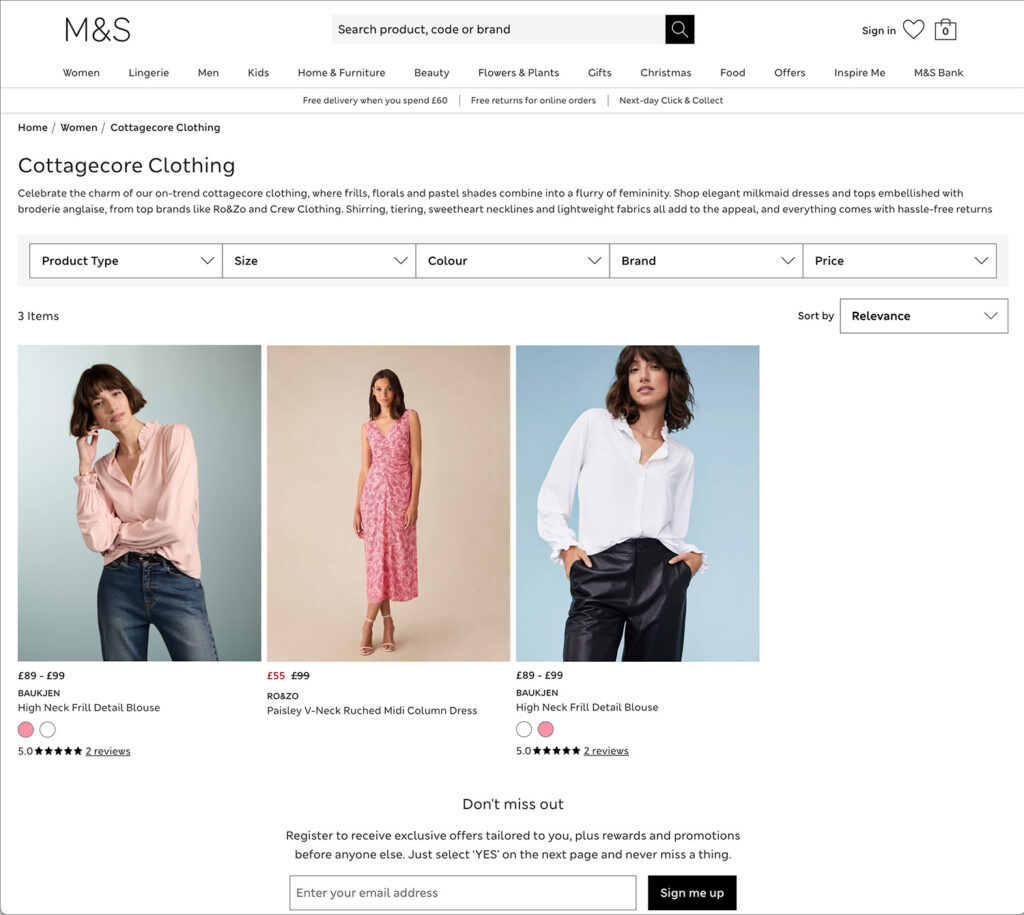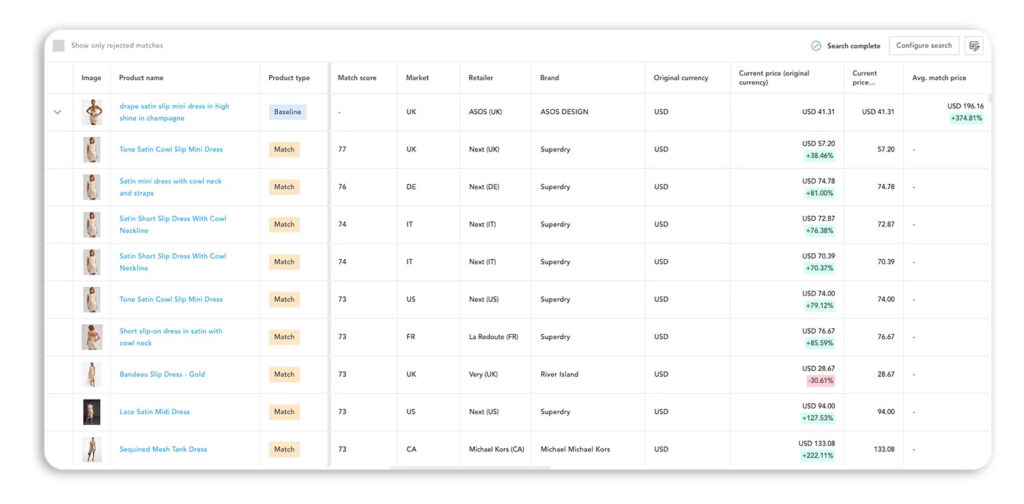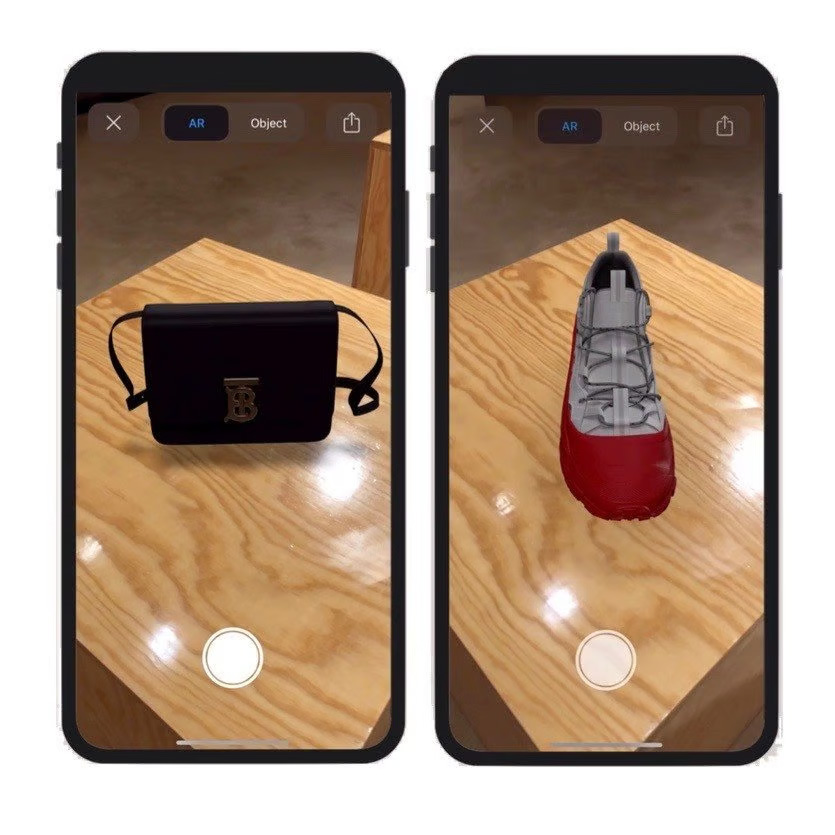Artificial Intelligence (AI) is reshaping fashion e-commerce, transforming everything from personalised shopping experiences to reducing operational and streamlining business. Technologies like machine learning, computer vision, and natural language processing enable brands to better understand consumer preferences, optimise operations, and respond quickly to market trends.
With half of Brits shopping for clothes online and the UK fashion market projected to reach £152 billion by 2024, AI is no longer a technological novelty but a strategic necessity for retailers aiming to thrive in this increasingly competitive landscape.
According to a recent study by IMRG & Hive, 75% of fashion retailers plan to invest in AI within the next 24 months, demonstrating AI’s importance for enhancing customer experiences, streamlining operations, and boosting sales.
See how ASOS, Marks & Spencer, Burberry and Unmade are already harnessing AI for personalisation, trend forecasting, and improving customer engagement. This article explores how AI is reshaping fashion retail, with real-world examples of its astonishing power.
1. Personalisation at Scale in Fashion E-commerce with AI
One of AI’s most impactful contributions to fashion e-commerce is delivering hyper-personalised shopping experiences at scale. Machine learning algorithms and data analytics allow brands to create tailored recommendations based on individual preferences, browsing history, and past purchases.
How ASOS Uses AI for Personalisation
- Product Classification: ASOS uses deep neural networks to classify products by attributes like colour, style, and occasion. This simplifies product discovery by allowing customers to filter through extensive ranges effortlessly.
- Collaborative Filtering & Session-Based Personalisation: ASOS identifies patterns in frequently purchased items by analysing customer-product interactions. The system dynamically adjusts recommendations in real-time based on browsing behaviour, ensuring relevant suggestions during each session.
- Hybrid Model for New Products: For new items without historical data, ASOS combines product attributes with customer interactions to recommend fresh styles.
- Brand Recommendations API: Powered by Azure Machine Learning, ASOS’s API offers personalised brand suggestions based on customer browsing and purchase history.
- Buy the Look (BTL): AI powers ASOS’s cross-selling tool, trained on 600,000 stylist-curated outfits. It recommends complementary items to complete customers’ looks.
- Fit Assistant: The Fit Assistant personalises size recommendations based on customer data, reducing returns.
- Visual Search: Style Match allows users to upload images and receive AI-driven product suggestions, simplifying the discovery process.

2. Enhanced Customer Insights Through AI
AI provides fashion brands with deep insights into consumer behaviour by analysing online activity, purchase history, and regional trends. This enables retailers to personalise marketing, optimise inventory, and accurately forecast demand.
Regional and Age-Based Preferences
In the diverse UK fashion landscape, AI helps retailers cater to regional differences:
- London: Cosmopolitan, trend-driven styles dominate.
- North of England: Practical, casual fashion is preferred.
- Scotland: Traditional textiles like tartan remain in high demand.
- Rural Areas: Distinct styles often differ from urban centres.
AI further tailors experiences based on age groups:
- Gen Z: Influenced heavily by social media trends.
- Millennials: Prioritise sustainability and ethical fashion.
- Gen X: Favour timeless, quality pieces.
- Baby Boomers: Prioritise comfort and practicality.
Real-World Example: Marks & Spencer’s AI-Driven Customer Insights
Marks & Spencer (M&S) has successfully integrated AI to remain competitive as consumer preferences evolve. Through its partnership with Microsoft, M&S leverages data from its Sparks loyalty programme, online browsing activity, and customer reviews to provide hyper-targeted marketing and operational efficiency.
Key results include:
- Personalised Marketing Campaigns: M&S sends targeted emails based on customer shopping habits, such as promoting eco-friendly products to sustainability-focused customers.
- Regional Stock Optimisation: AI helps M&S adjust stock levels to meet local demand, such as supplying more waterproof jackets to Scotland.
- Age-Specific Product Development: AI insights led M&S to expand loungewear during the remote working boom, a category increasingly popular with Millennials.
- Trend Forecasting & Sentiment Analysis: By analysing social media and customer reviews in real-time, M&S adapts quickly to trends, such as the rise in cottagecore-inspired fashion.
M&S reported a 53.9% increase in online sales in 2021, with AI playing a key role in their digital transformation.

3. AI-Powered Trend Forecasting
AI is a crucial tool for predicting trends by analysing social media, search data, and sales figures. It helps fashion brands stay ahead, produce only what will sell, and reduce waste, enhancing sustainability.
How AI Predicts Trends:
- Social Media Analysis: AI analyses millions of posts on Instagram, TikTok, and Pinterest to identify trending styles and hashtags, such as #sustainability or #cottagecore.
- Visual Recognition: AI-powered image recognition detects patterns in social media images, helping brands pinpoint emerging trends, from streetwear to formal wear.
- Sentiment Analysis: AI gauges public opinion on various trends through hashtags and user comments, helping brands gauge how consumers feel about different styles.
Runway Influence:
AI also helps fashion brands analyse data from runway shows like London Fashion Week, identifying key cuts, fabrics, and colours that will trickle down into mainstream fashion.
Online Search and Sales Data:
AI analyses search queries and sales data to forecast consumer interest. Platforms like EDITED help brands track and understand sales trends, ensuring they respond swiftly to shifting demand.
4. Operational Efficiency Through AI in Fashion
AI is reshaping operations by helping fashion brands optimise supply chains, manage inventory, and implement dynamic pricing. Brands like Marks & Spencer and ASOS have seen improved stock availability, reduced markdowns, and real-time pricing, giving them a competitive edge in a fast-moving industry.
Supply Chain Optimisation:
AI-powered predictive analytics forecast demand with precision, helping brands avoid overproduction and reduce excess inventory. AI helps optimise stock levels and reduce warehouse costs by predicting when and where products will be in demand.
Waste Reduction & Sustainable Production
AI assists fashion retailers in implementing more sustainable practices by forecasting demand accurately, reducing waste caused by overproduction. Additionally, it identifies opportunities to upcycle or recycle unsold products, aligning with the UK’s focus on eco-conscious fashion.
Real-World Example: Marks & Spencer
M&S saw a 1.5% increase in product availability and a 5.9% reduction in markdowns after integrating AI into its supply chain. This allowed them to better meet consumer demand while reducing waste.
Automated Quality Control
AI-driven computer vision technology allows for real-time defect detection, ensuring that garments meet quality standards faster and more accurately than traditional methods. This improves consistency in craftsmanship for high-quality British brands like Burberry.
Real-World Example: Burberry
Burberry employs AI to ensure that its iconic check pattern is consistent across all products. AI-driven image recognition technology scans garments to maintain uniformity, upholding Burberry’s quality and reinforcing its brand identity whilst also preventing counterfeiting.
AI Photoshoot
AI-driven image rendering technology automates the creation of high-quality images of clothing on virtual models, eliminating the need for physical photoshoots. This solution is especially beneficial for companies with limited budgets, quick product turnovers, or extensive product lines where traditional photoshoots are impractical. By reducing production costs and turnaround times, AI Photoshoot enhances operational efficiency and helps improve conversion rates, enabling brands to connect with their audience effectively despite budget or time constraints.
5. Dynamic Pricing Strategies
AI enables fashion retailers to adjust prices based on factors such as market demand, competitor pricing, and inventory levels in real time.
Personalised Pricing
AI tailors pricing strategies to specific customer segments, offering personalised discounts or promotions based on purchasing behaviour without undercutting profitability.
Real-World Example: Mango
Mango uses EDITED’s market data to localise pricing and optimise assortments across different regions. By leveraging data on competitor pricing and trends, Mango adjusts product mixes and pricing strategies based on regional demand and market conditions. This has helped the brand maintain competitiveness and align its offerings with customer expectations in various countries. The tool has also improved efficiency by automating data collection and analysis, saving Mango valuable time.

6. AI’s role in Managing Customer Experience
AI-powered chatbots, virtual assistants, and augmented reality (AR) are reshaping customer interactions with fashion brands. These tools provide personalised recommendations, 24/7 support, and virtual try-ons, all of which significantly enhance the shopping experience while reducing returns.
AI-Powered Chatbots
AI-driven chatbots like ASOS’s Enki offer real-time customer support and tailored product recommendations. By analysing customer preferences, Enki enhances engagement by providing relevant suggestions, whether through browsing history or specific queries. One of its key features is the visual search capability, where users can upload images of items they like. The chatbot then scans ASOS’s extensive inventory to find similar products, making it easier for customers to discover styles that match their preferences.
Since its launch, Enki has significantly boosted customer engagement and conversion rates for ASOS. By offering round-the-clock, personalised assistance, it helps customers navigate the vast product range (over 80,000 items), ultimately improving the shopping journey and increasing sales.
Augmented Reality (AR)
AR technology elevates online shopping by enabling customers to virtually try on clothing and accessories. This immersive experience offers a realistic preview of how garments will look and fit, reducing uncertainty and boosting confidence in purchasing decisions. As a result, AR not only helps lower return rates but also enhances customer satisfaction by delivering a more informed and interactive shopping experience.
Real-World Example: Burberry’s AR Shopping Tool
Luxury fashion brand Burberry has implemented AR to enrich its online shopping experience. Burberry’s AR tool allows customers to place virtual products—such as handbags—within their personal spaces, enabling them to see how the items fit into their existing wardrobe. This innovative approach to visualising products bridges the gap between online and physical shopping, leading to increased customer engagement and higher conversion rates.

Try on with Human Avatar Augmentation
Customers simply upload a headshot and basic measurements to instantly see multiple realistic, flattering products on themselves. Zyler leverages advanced AI to combine these inputs with your product images and size charts, creating a seamless virtual dressing room experience.
Size and Fit Finders
Size and fit finder tools are essential in e-commerce, helping customers choose the right size for clothing by offering personalised recommendations based on body measurements, previous purchases, brand comparisons or matching body dimensions to SKU. There are an array of these tools that look similar at the front end but all work very differently in the back end.
These tools boost customer confidence, reduce return rates, and enhance the shopping experience by eliminating the guesswork in sizing.
Additionally, they provide retailers with valuable data on customer preferences, aiding in product design and inventory management, while also increasing conversion rates by giving shoppers the assurance they need to complete a purchase.
Footwear Size Finder
Measures foot dimensions from a single photo taken with a phone camera and matches them to the shoe SKU. The Shoe Size Finder continuously learns from sales and returns data, improving accuracy over time.
Real-world Example: Reebok
Leading footwear brand Reebok uses Shoe Size Finder to ensure that customers get the right shoe size when ordering shoes online, which reduces returns and boosts conversions as customers are more sure of their purchase.

7.Customisation at Scale
AI is empowering mass customisation, enabling customers to design personalised garments at scale. This not only elevates the customer experience but also fosters brand loyalty by offering unique, tailor-made products.
Real-World Example: Unmade and New Balance
Unmade partnered with New Balance Team Sports to streamline the customisation process for team apparel. By using Unmade’s platform, New Balance enables teams to personalise uniforms and gear while maintaining efficient production and supply chain operations. This collaboration has helped New Balance scale personalised team sportswear offerings without sacrificing speed or quality. The platform simplifies customisation, reduces lead times, and supports mass customisation at scale.
Conclusion: Embracing AI for a Competitive Edge in UK Fashion
AI is transforming every facet of the fashion industry, from operational efficiency to customer engagement. By harnessing AI, brands like Marks & Spencer and ASOS are enhancing their supply chains, improving quality control, and staying competitive with dynamic pricing strategies.
AI-powered tools, such as virtual assistants and augmented reality, are elevating customer experiences by offering seamless, personalised shopping journeys. At the same time, AI-driven customisation allows brands to offer bespoke products at scale, creating deeper emotional connections with consumers.
As AI technologies continue to evolve, UK fashion brands have an opportunity to lead the charge in innovation. By embracing AI, they can improve operational efficiency, meet the growing demand for personalisation and sustainability, and ensure they stay ahead in an increasingly competitive market.